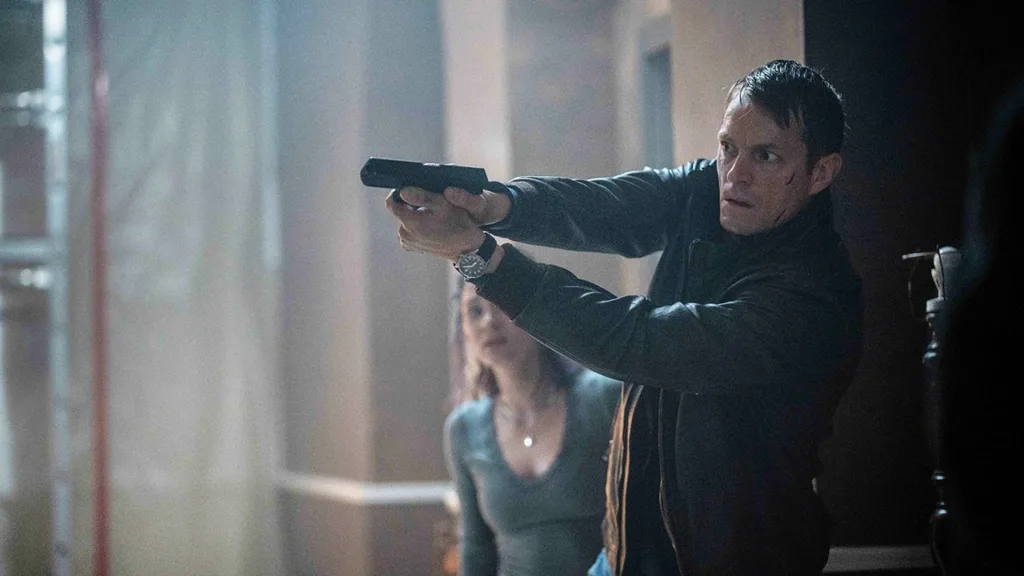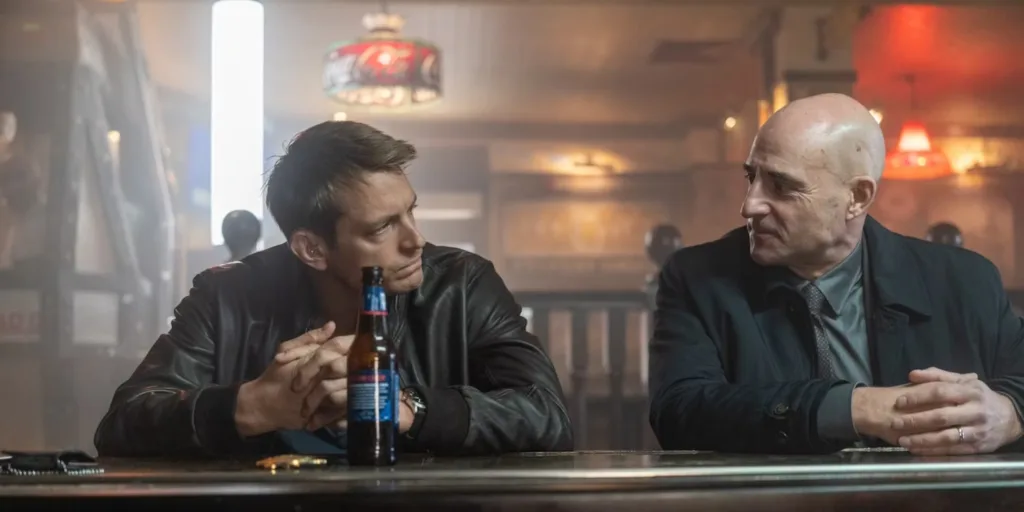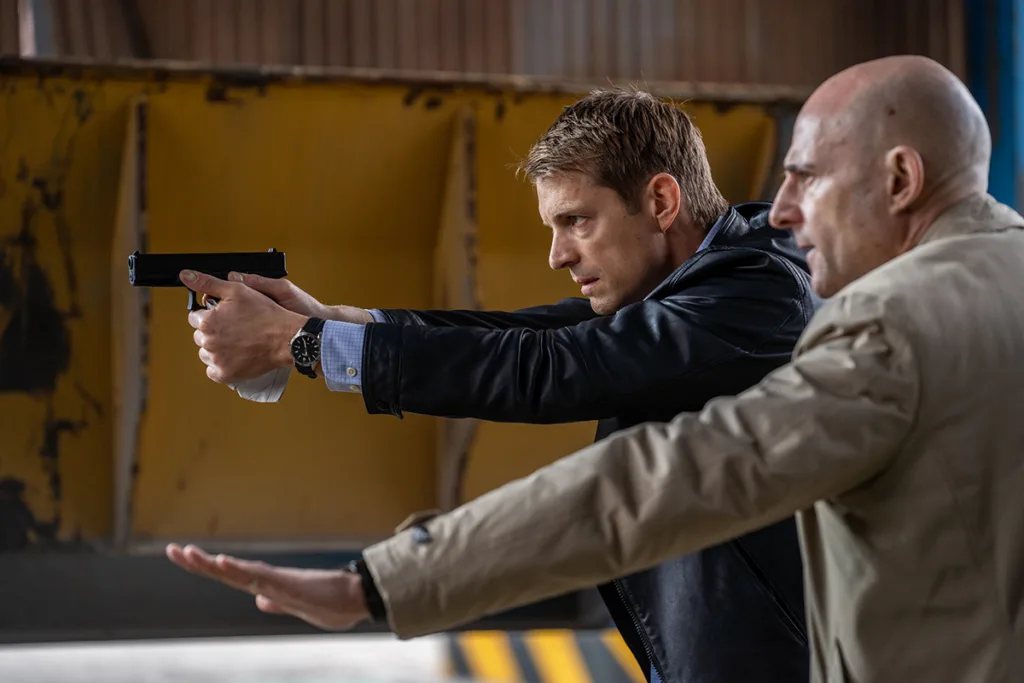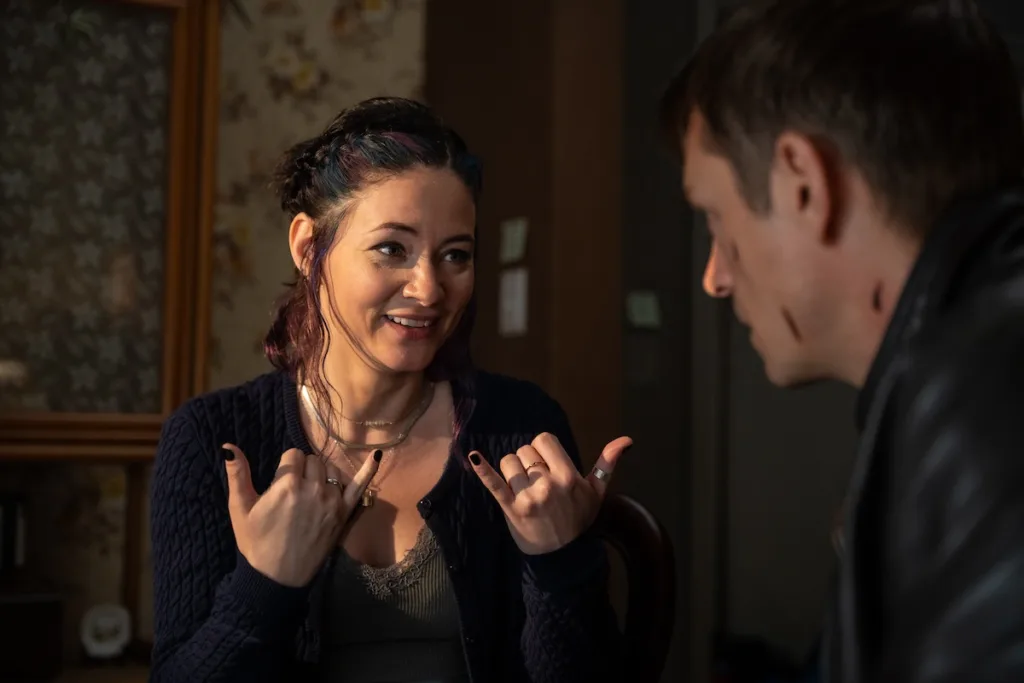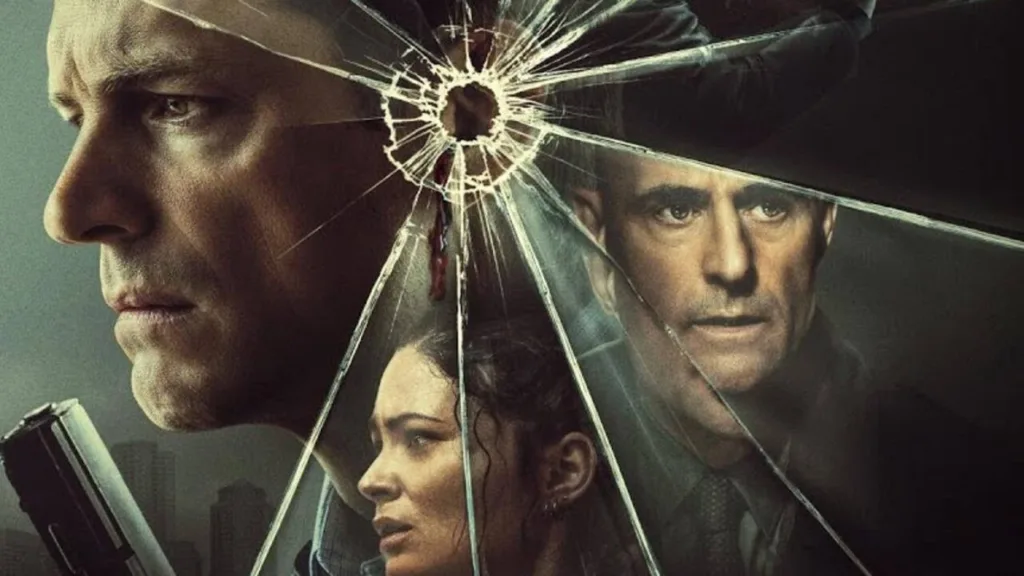Brad Anderson’s Silent Hour is a gripping story that combines human conflict with high-stakes suspense. With Joel Kinnaman as Detective Frank Shaw, Sandra Mae Frank as Ava, Mark Strong as his friend Doug Slater, and Mekhi Phifer as the villain, the film explores the difficulties experienced by people with impairments in navigating a hazardous environment.
Filmed against the background of a soon-to-be-condemned Boston apartment building, the narrative centers on Detective Shaw, who has gradual hearing loss after a failed police operation. His life veers dramatically when he is assigned to translate for Ava, a deaf witness to a murder connected to gangs. As the exact criminals they are attempting to avoid approach them, the conflict becomes more intense, and it becomes a cat-and-mouse game that has both exciting and emotionally heavy results.
Released on October 11, 2024, The Silent Hour seeks to challenge the conventional wisdom of the classic thriller by emphasizing people who must depend on their wits and each other to live in an environment that magnifies their weaknesses. Anderson’s direction promises a distinctive investigation of sound and quiet as well as an exciting framework for the drama that is developing.
Navigating Silence: The Intricate Plot of The Silent Hour
Joel Kinnaman’s Detective Frank Shaw, a committed Boston officer whose life is irreversibly changed by a horrible event, takes the stage in The Silent Hour. Frank sustains a severe head injury in a high-stakes pursuit to capture a suspect that causes lifelong hearing loss.
Along with his work, this horrific event profoundly influences his relationships, especially with his teenage daughter Sami, who yearns for the father she once knew. Frank struggles with both his professional identity and personal relationships, and the emotional weight of his new reality drives him into seclusion.
Frank is unwillingly taken off desk duty to act as an interpreter for Ava Fremont, a deaf witness portrayed by Sandra Mae Frank, during the inciting event. Ava has vital knowledge about a horrific gang murder she saw, and her testimony raises serious questions when the very offenders implicated find out. Their danger is great as gang boss Mason Lynch, played by Mekhi Phifer, wants to quiet Ava before she can provide any proof to the police.
The movie’s main location, a run-down apartment building scheduled for destruction, is more than just a background; it becomes a character unto itself. As Frank and Ava negotiate their surroundings, attempting to hide from the gang members closing in on them, the empty, echoing corridors and secret nooks heighten the suspense.
Frank and Ava are besieged and must depend on their limited means of communication and creativity to live, hence creating the central conflict. As they come into challenges that expose their weaknesses—such as Frank’s difficulties with his hearing aids and the requirement of good sign language communication—essential story turns develop.
The movie deftly strikes a mix between tense moments and peeks into the histories of the individuals, therefore enhancing the story and keeping spectators on edge. The stakes become more personal as their precarious predicament gets worse, guiding the story toward an erratic conclusion.
Character Depth and Dynamics in The Silent Hour
The core of The Silent Hour is Joel Kinnaman’s Frank Shaw. His character path is gripping, highlighting the great challenges of a once-confident investigator now coping with the facts of hearing loss. As both a police officer and a parent, Kinnaman deftly captures Frank’s inner conflict—his dissatisfaction and concern over losing his identity. His infirmity clearly weighs emotionally, particularly in situations with his daughter, Sami.
Their tense interaction emphasizes Frank’s sense of inadequacy; he wants to help her but his illness prevents him. Authenticity permeates Kinnaman’s portrayal, which deftly captures the subtleties of a man negotiating a new and lonely world while recovering his previous self.
Sandra Mae Frank’s Ava Fremont gives the movie yet another level of complexity. She suffers from addiction, among other problems, as a deaf lady with a rough history. Although she is in danger as she saw a horrible incident, her perseverance is shown. Ava’s character shows agency and power, especially in her contacts with Frank; she is not just a victim.
Sandra Mae Frank embodies the complexity of a woman resolved to face her history while battling for survival, giving a performance that seems both raw and real. Her performance gives the movie a necessary realism so viewers may relate to her suffering.
Frank finds stability in Mark Strong’s character, Doug Slater. Doug’s relentless support and encouragement as Frank’s partner help to offset Frank’s self-doubt. Strong’s portrayal is excellent; their relationship gains complexity from his pragmatic but sympathetic nature.
The way Mekhi Phifer presents Mason Lynch, the adversary, sharpens the suspense in the movie. Lynch is multifaceted and sophisticated, motivated by desperation and a strong urge to defend his interests, not just any old villain. Phifer is a great opponent, as his subtle acting helps viewers to grasp the reasons behind Lynch’s brutal acts.
The suspense of the story is enhanced by other supporting characters, like the gang members and the physician portrayed by Djinda Kane, each of which adds special features raising the stakes for Frank and Ava. These individuals taken together enhance the narrative, therefore transforming The Silent Hour into a multifarious investigation of struggle, resiliency, and the battle for existence in a society often seen to be rather hostile.
Themes of Struggle and Resilience in The Silent Hour
Through Frank Shaw’s journey, the Silent Hour powerfully explores the difficulties of living with a handicap. Frank negotiates a society that further alienates him as a detective struggling with gradual hearing loss. The movie does a good job of capturing his annoyance—be it with regard to broken hearing aids or a disconnection from his kid. These difficulties draw attention to the emotional and pragmatic modifications required by people with disabilities, therefore highlighting their everyday struggles in a society too frequently ignoring their needs.
Frank and Ava’s relationship deftly incorporates survival as a motif. Their dependence on one another helps them to develop great trust when they are surrounded by gang members. As they learn to negotiate their dangerous circumstances together, their cooperation develops from simple need to a strong friendship. Their exchanges highlight the need for connection while confronting insurmountable challenges as they show how trust could be a lifeline in dire situations.
The movie also subtly but importantly comments on social concerns, including gentrification and displacement. The story takes place against the harsh background of the apartment complex, a once-vibrant community now on the verge of destruction. Reflecting more general society problems that transcend the movie, it represents the uprooting of underprivileged people in metropolitan environments.
Another important thread is personal development, particularly in Frank’s emotional trip. He starts toward resilience and acceptance slowly as he faces his constraints and worries. His connection with Ava reminds viewers that, despite hardship, development usually results from a sense of direction. By means of their common hardships, both characters show the power inherent in vulnerability, therefore stressing the human potential to adjust and flourish in spite of obstacles in daily life.
Crafting Tension: Anderson’s Direction and Visual Language in The Silent Hour
Emphasizing tension and emotional depth, Brad Anderson’s directing of The Silent Hour shows a rigorous commitment to narrative. Renowned for his earlier films, such as The Machinist and Session 9, Anderson uses his background to create a cramped environment that accentuates the tension of the movie.
The slow pace lets calm times for contemplation mix with spurts of activity. This harmony ensures a consistent build-up of tension while nevertheless immersing viewers in Frank and Ava’s terrifying ordeal.
Themes of the movie are enhanced by the photography. Using tight passageways and low lighting to create a feeling of captivity, the apartment building—a major scene—is filmed with great attention for composition. Often hovering in close quarters, the camera visibly captures the growing dread of the individuals. This geographical awareness not only sharpens the stakes but also captures Frank’s inner conflict with his new world.
Complementing the visual tale depends much on sound design. Anderson deftly uses sound to transport viewers to Frank’s perspective, alternately between quiet and distorted audio that replicates his hearing issues. Frank’s uncertainty and irritation are let the audience experience by this creative use of sound.
Anderson’s directing and the photography of the movie together create a strong story that deftly examines survival and adaptation within an aesthetically and aurally pleasing context.
Balancing Tension and Predictability in The Silent Hour
The Silent Hour has a number of strong points that set it beyond usual genre fare. The film’s thrilling scenes—especially the cat-and-mouse interactions between Frank Shaw and the chasing gang members—are among its most successful features. Every sound and shadow Frank and Ava negotiate the dark, deserted apartment complex increases the stakes.
The obvious connection between Kinnaman and Frank gives their relationship emotional depth and accentuates these moments. Their exchanges seem real, with Kinnaman’s depiction of Frank’s sensitivity set against Ava’s fortitude. Quiet times, including those when they tell personal experiences that highlight their different challenges, accentuate this emotional link and help to anchor the story in genuine human experience.
Still, the movie has some flaws. Its predictability is a major disadvantage, as many story turns may be expected well in advance, therefore reducing the general suspense. Often, depending too much on well-known thriller clichés—such as the heroic officer and the vulnerable witness—results in a formulaic approach that seems too secure.
Although the movie sets up interesting character relationships, it falls short in properly examining their emotional complexity. Deeper exploration of Frank’s psychological condition after an injury, for example, may have enhanced the story and presented a more complex picture of his challenges and victories.
Pace also becomes a problem, especially in the second act when several events seem repetitious. Sometimes Frank and Ava hide from their captors using identical strategies, which causes stalemate. This repetition lessens the urgency the story first creates. Although The Silent Hour successfully portrays suspense and character development, it finally loses the chance to challenge its limits and provide a more creative thriller experience.
Final Thoughts on The Silent Hour
Anchored by outstanding performances from Joel Kinnaman and Sandra Mae Frank, The Silent Hour offers a convincing blend of tension and emotional depth. Examining issues of disability and survival with a remarkable attention on character development, the film deftly portrays the tension of its premise. Its potential effect is lessened, nevertheless, by its dependence on well-known thriller clichés.
Although the picture sometimes suffers in tempo and emotional development, leaving several character arcs undeveloped, the exciting events and the chemistry between the stars are notable. The Silent Hour is worth seeing despite these flaws because of its original viewpoint on the lives of people with disabilities and shows their resiliency under trying conditions.
Within the larger framework of the thriller subgenre, the movie distinguishes itself for its portrayal of hearing loss and provides viewers with a novel narrative prism. In the end, it asks audiences to consider the difficulties experienced by people with disabilities, therefore adding a major contribution to modern film that aims for more inclusiveness and empathy.
The Review
The Silent Hour
Driven by excellent performances from its stars, the suspenseful thriller The Silent Hour deftly combines emotional depth. Although it presents a novel viewpoint on disability and survival, its predictability and pace problems prevent it from realizing its full potential. Particularly for those who like complex character studies within the thriller genre, the movie is well worth seeing.
PROS
- Strong Performances
- Engaging Premise
- Suspenseful Sequences
- Character Development
CONS
- Predictable Plot
- Underdeveloped Characters
- Limited Exploration of Themes









































